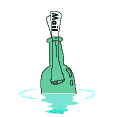I.D. Letters.
With apologies for the poor quality, we have reproduced this list directly from the original manuals. As this is an important source of information we hope you find it useful. As an added feature I have retyped a table supplied by Ian Talmage, based on the original info, I hope it might be easier to read and maybe have extra info available. When I am satisfied all my gremlins are out of it and I have added as much as I can, I might delete the first one, but at the moment I leave both, as the first one came direct from the horses mouth, so to speak, British Seagull.
Scan right down to the bottom of the page for the latest edition. I think these tables are about as correct as I can get them, I will remove the originals at some time, when I'm sure!
John SOS
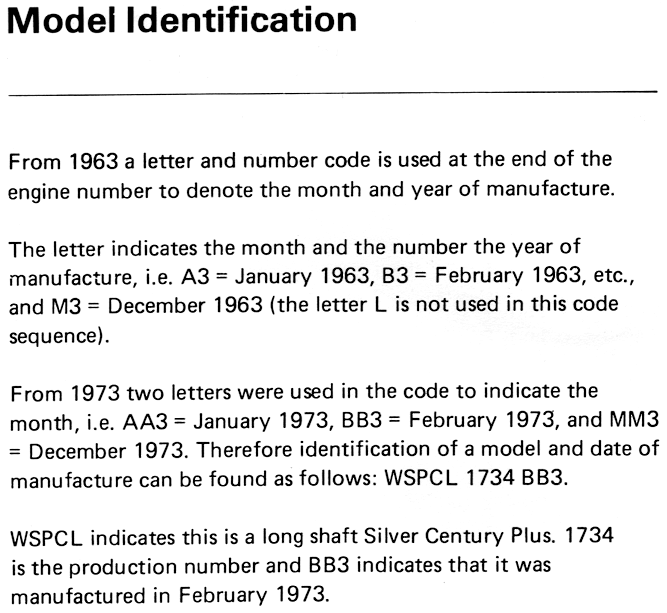
In 1980 Electronic ignitions were installed, engines having the E prefix from that date.
In the numbers below, for early years, some of the numbers do not appear to make sense. For instance in 1933 the numbers appear to run backwards, or should 300 be 800?
In 1934 the Super model OF the use of a ')' symbol appears. As I have seen this motor and it has the number 'O' instead, it looks as if a typist simply pressed the ')' instead of the '0', by hitting shift at the same time. The use of the number '0' in all the previous models tends to bear this out. There may well be other typo's in these numbers, but they are as good as it gets folks!
I have just had a little snippet from Charles Palfreeman in Poole. his research has added another letter to a few of the motors. August 06.
The FVP and FV motors had the factory option for a while, of a lifting or pivoting tiller. the engine was suffixed with a 'T' and a bent bracket fixed to the crankcase, to pivot the tiller on. the for runner to the casting! Well Found Charles. I have checked and yes, the two I have confirm it!
The Little Forty models.. There is the model LM missing from the letter codes, fore runner to the SJM I believe. See the Little Forty's page for more. March 2007, I have had it confirmed that the 'F' did exist, I have seen one, thanks to Mike Williams for showing it to me!
The use of the letter 'W' in the dating codes.
For a long time I suspected it was not a 'W' but in fact an inverted 'M', and yes I have seen a few, but new light has dawned, from Frank Arnold. It seems they did in the early 1970's fit a number of 102's with 'Wipac' ignitions and they had the letter 'W' added with the year... they did not do it for long as it was not a very useful exercise, after all you could see the darn thing had a wipac if you looked at it and you did not know what month it was built... I have found several of these now and had a dozen or more reported to me, but recently I turned up another upside down 'M' so you have to look carefuly!
The Marston Seagulls start here:-
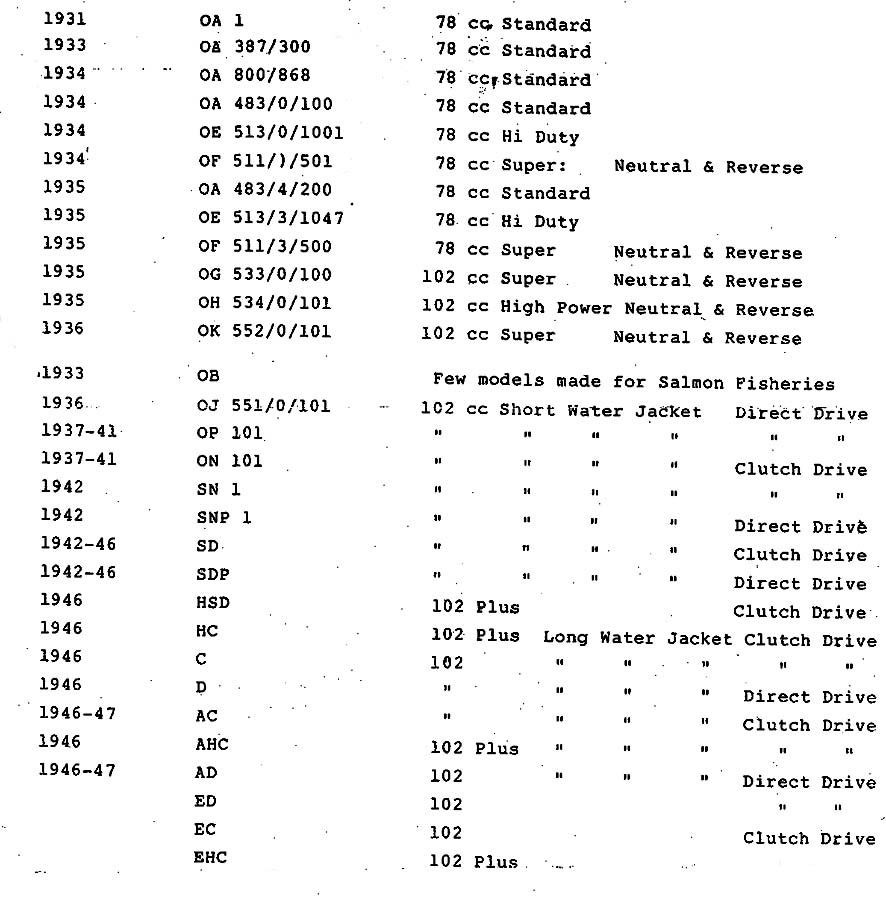
Below the letters and numbers for the Little Forty models. the 'F' was used, have seen one now and also there was an 'LM'.
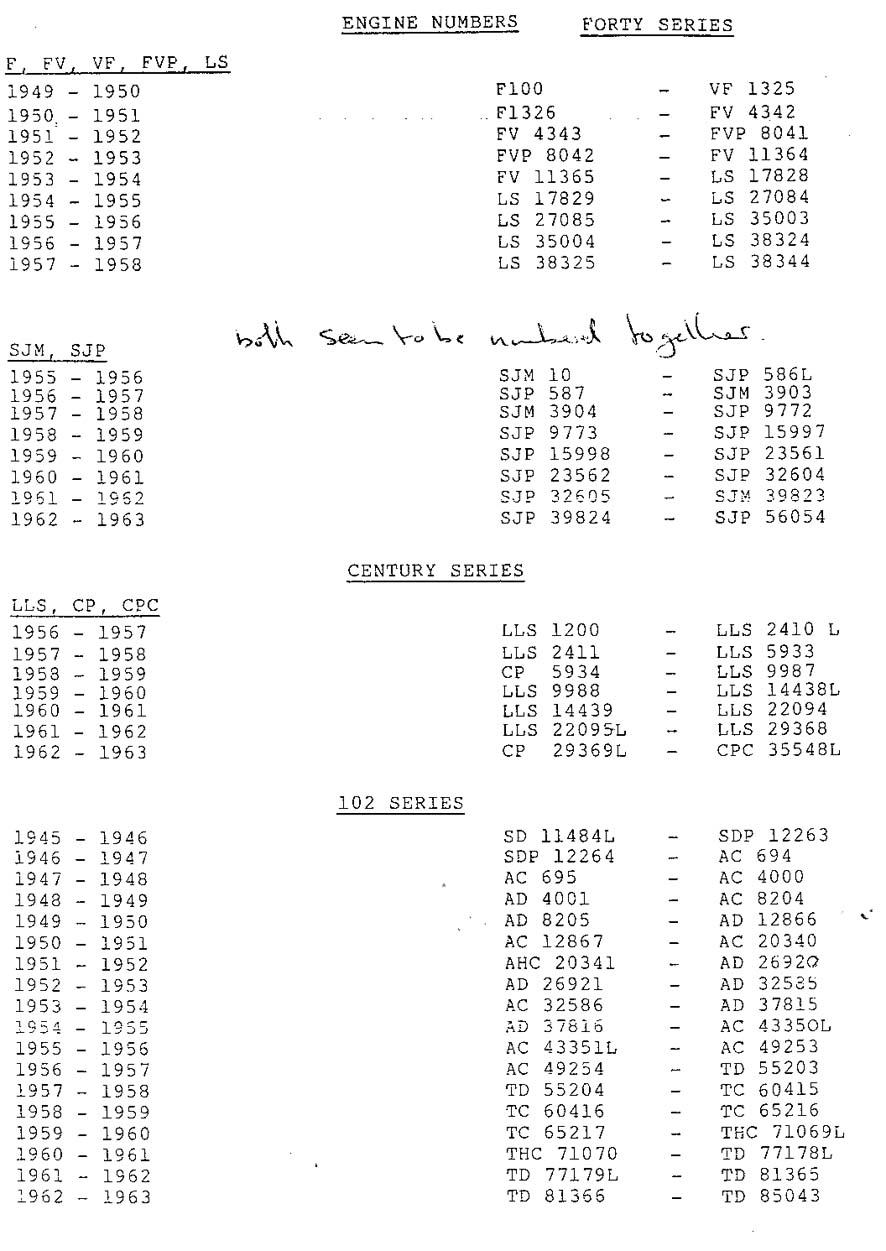

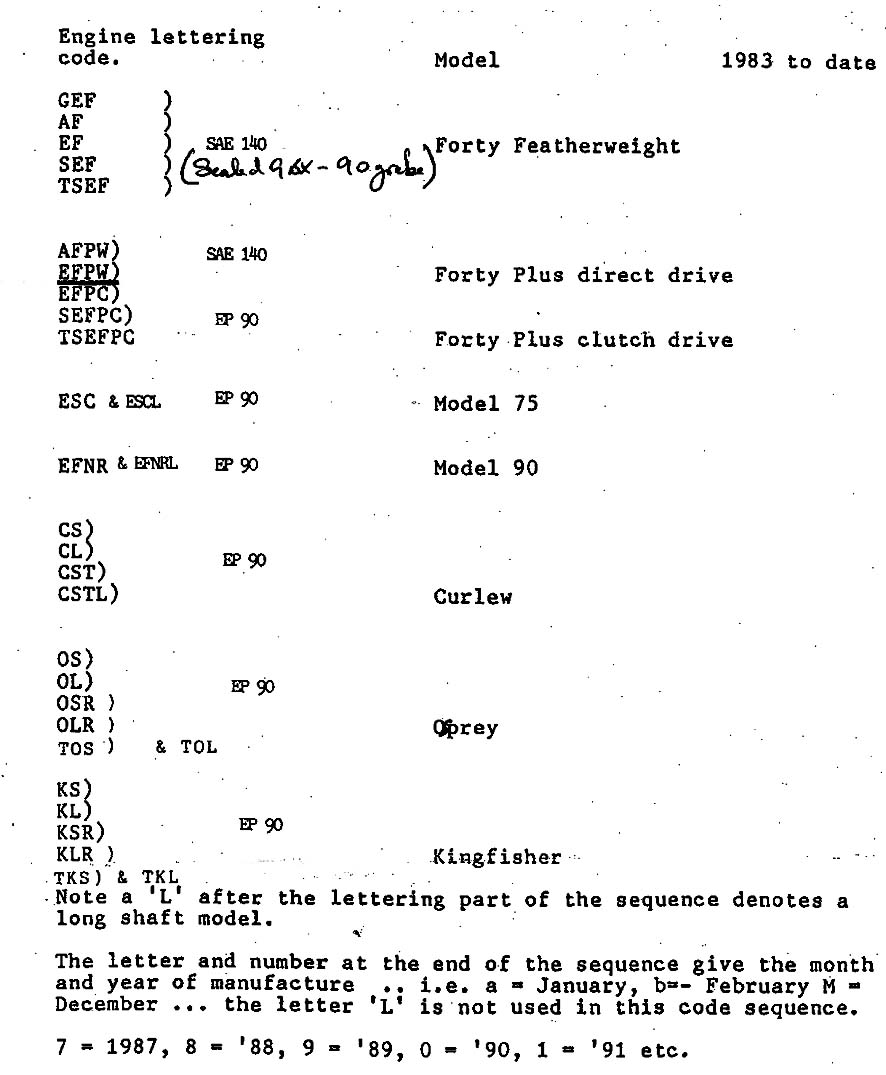
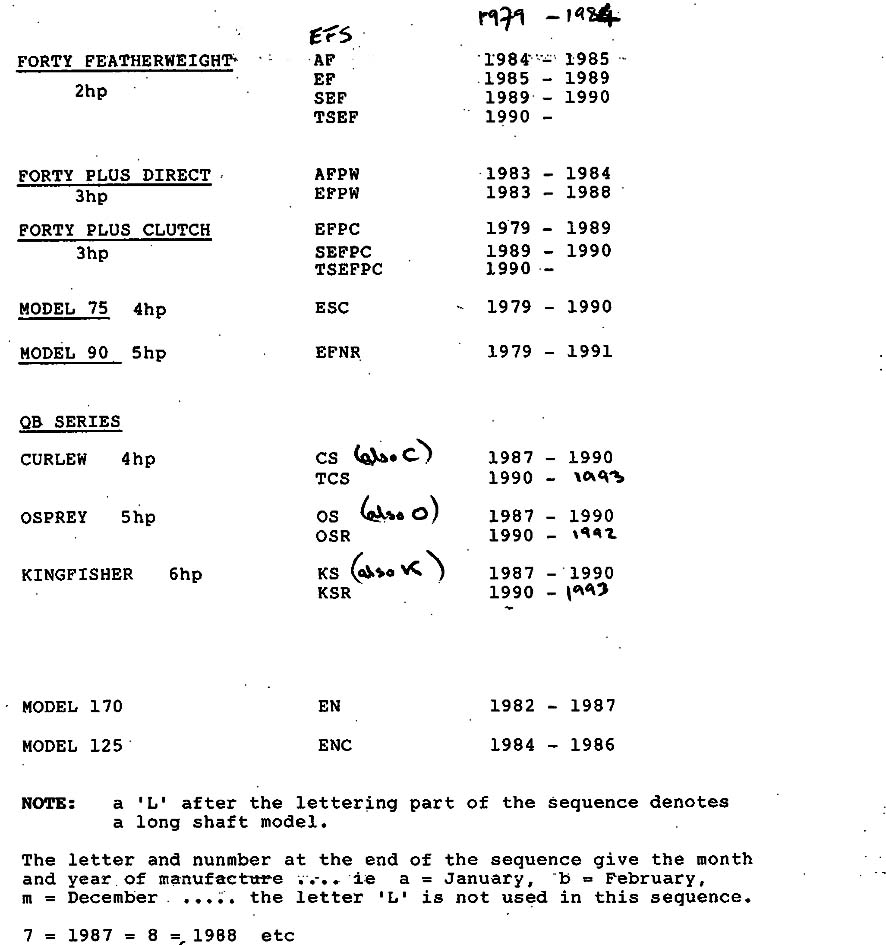
Below is the updated list.
My grateful thanks to Ian for the time taken in sorting this out and donating it to the site for all to read.
John SOS
Engine - Letter Code - for Month/Year Manufactured
Model Identification - Month & Year Defined
From 1963 a letter and number code is used at the end of the engine number to denote the month and year of manufacture.
The letter indicates the month and the number the year of manufacture, i.e. A3 = January 1963, B3 = February 1963, etc., and M3 = December 1963 (the letter L is not used in this code sequence).
From 1973 two letters were used in the code to indicate the month, i.e. AA3 = January 1973, BB3 = February 1973, and MM3 = December 1973. Therefore identification of a model and date of manufacture can be found as follows: WSPCL 1734 BB3.
WSPCL indicates this is a long shaft Silver Century Plus. 1734 is the production number and BB3 indicates that it was manufactured in February 1973.
| 1963 to 1972 | 1973 to 1982 | ||
| Letter | Month | Letter | Month |
| A | January | AA | January |
| B | February | BB | February |
| C | March | CC | March |
| D | April | DD | April |
| E | May | EE | May |
| F | June | FF | June |
| G | July | GG | July |
| H | August | HH | August |
| J | September | JJ | September |
| K | October | KK | October |
| M | November | MM | November |
| N | December | NN | December |
The above table is still not 100% as the letters N were not used every year, December being M, so one can assume another letter was used somewhere. As it was not supposed to be 'L', that only leaves 'I'. However I have never seen one stamped with 'I' or 'II', looks too much like a numeral.... Need to look through a few hundred crankcases to figure this one out....
John
Model Identification - Letter Definitions
Some of the letters in the engine lettering code stand for different parts of the particular models. Below is a list of some of the letter meanings:
| Letter | Meaning |
| A | Amal 400 series Carb |
| E | Electronic Ignition Wipac Mk3 or 4 |
| G | Bing Carb |
| L | Long Shaft. This letter code was added after all the engine number pre ’63 and as a suffix to the code letters after ’63. |
| R | Reconditioned. used as a suffix. There is no record of when some engines were factory reconditioned, others seem to have the year code after the ‘R’ |
| S | Silver models/ Sealed Gearbox (90 grade Oil) |
| W | used on some motors as a suffix to denote Wipac ignition fitted. Notably 102 models |
| T | Twist Grip fitted at factory. Could be retro-fitted on many models |
| T | As a suffix on the early FV and FVP for Tiller on bracket! |
Engine - Letter Code - for Early Models, including the Marston Seagulls.
| Year Manufactured | Engine Lettering Code | Engine No. | Engine Size (cc) /Name | Series |
| 1931 | OA | 1 | 78 | Standard |
| 1933 | OA | 387/300? | 78 | Standard |
| 1934 | OA | 800/868? | 78 | Standard |
| 1934 | OA | 483/0/200 | 78 | Standard |
| 1934 | OE | 513/0/1001 | 78 | Hi Duty |
| 1934 | OF | 511/0/501 | 78 | Super: Neutral & Reverse |
| 1935 | OA | 483/4/200 | 78 | Standard |
| 1935 | OE | 513/3/1047 | 78 | Hi Duty |
| 1935 | OF | 511/3/500 | 78 | Super: Neutral & Reverse |
| 1935 | OG | 533/0/100 | 102 | Super: Neutral & Reverse |
| 1935 | OH | 534/0/101 | 102 | High Power: Neutral & Reverse |
| 1936 | OK | 552/0/101 | 102 | Super: Neutral & Reverse |
| 1933 | OB | Few models made for Salmon Fisheries | ||
| 1936 | OJ | 551/0/101 | 102 | Short Water Jacket - Direct Drive |
| 1937-41 | OP | 101 | 102 | Short Water Jacket - Direct Drive |
| 1937-41 | ON | 101 | 102 | Short Water Jacket - Clutch Drive |
| 1942 | SN | 1 | 102 | Short Water Jacket - Clutch Drive |
| 1942 | SNP | 1 | 102 | Short Water Jacket - Direct Drive |
| 1942-46 | SD | 102 | Short Water Jacket - Clutch Drive | |
| 1942-46 | SDP | 102 | Short Water Jacket - Direct Drive | |
| 1946 | HSD | 102 Plus | Short Water Jacket - Clutch Drive | |
| 1946 | HC | 102 Plus | Long Water Jacket - Clutch Drive | |
| 1946 | C | 102 | Long Water Jacket - Clutch Drive | |
| 1946 | D | 102 | Long Water Jacket - Direct Drive | |
| 1946-47 | AC | 102 | Long Water Jacket - Clutch Drive | |
| 1946 | AHC | 102 Plus | Long Water Jacket - Clutch Drive | |
| 1946-47 | AD | 102 | Long Water Jacket - Direct Drive | |
| ED | 102 | Direct Drive | ||
| EC | 102 | Direct Drive | ||
| EHC | 102 Plus | Clutch Drive |
The question Marks mean the numbers either were missing or do not make sense. For instance the 1933 engine numbers seem to indicate just a few motors were made, or is the 3 really an 8? Which would make sense. However what happened to 1932? Lumped in with 1933 maybe? No one will tell me, no one seems to know. I hope shortly to get a definitive list of Early British Seagull Models, from the first Model 'A' to the first British Seagull 102's. I will create a special page just for the Marstons and transfer all the info on them to it. As far as we can gather, from the motors surviving, not many were indeed made, maybe as few as 1,000. John
The 1949 to 50's Model 'F' was doubted for a while, but in March 2007 I had pics of one sent in by Mike Williams. I was right not to doubt the British Seagull info! John
| FORTY SERIES | ||
| Year Manufactured | Engine Lettering Code | Engine No |
| The ‘Little Forty’ Series | ||
| 1949-50 | F | 100 |
| 1949-50 | VF | 1325 |
| 1950-51 | F | 1326 |
| 1950-51 | FV | 4342 |
| 1951-52 | FV | 4343 |
| 1951-52 | FVP | 8042 |
| 1952-53 | FVP | 8042 |
| 1952-53 | FV | 11364 |
| 1953-54 | FV | 11365 |
| 1953-54 | LS | 17828 |
| T As a suffix | On the FV and FVP for 'Tiller on bracket'! (As opposed to fixed tiller on crankcase.) Well done Charles Palfreeman for researching this snippet. | |
| The LM model | This is missing from the tables? Not sure why it does not appear, but it appears to have run alongside the LS... | |
| The later ‘Forty’ series and some ‘Little Forty models. | ||
| 1954-55 | LS | 17829 |
| 1954-55 | LS | 27084 |
| 1955-56 | LS | 27085 |
| 1955-56 | LS | 35003 |
| 1955-56 | SJM | 10 |
| 1955-56 | SJP | 586L |
| 1956-57 | LS | 35004 |
| 1956-57 | LS | 38324 |
| (The LS was made till the end of 1957) | (In my little collection I now have acquired SJP 1 from 1955 Awaits restoration!) | |
| 1956-57 | SJP | 587 |
| 1956-57 | SJM | 3903 |
| 1957-58 | LS | 38325 |
| 1957-58 | LS | 38344 |
| 1957-58 | SJM | 3904 |
| 1957-58 | SJP | 9772 |
| 1958-59 | SJP | 9773 |
| 1958-59 | SJP | 15997 |
| 1959-60 | SJP | 15998 |
| 1959-60 | SJP | 23561 |
| 1960-61 | SJP | 23562 |
| 1960-61 | SJP | 32604 |
| 1961-62 | SJP | 32605 |
| 1961-62 | SJM | 39823 |
| 1962-63 | SJP | 39824 |
| 1962-63 | SJP | 56054 |
Throughout the years above various codes were used during each year, ie F, FV, FVP, LM, LS, SJM, SJP. The years codes start with the first motor of whatever sort, that was made. Obviously the FV and FVP ceased in about 1953, the LS in !957. Strangely the LS and the SJP overlapped for 2 years.. but then the 102 production went on till 1977, alongside the Centuries....
| CENTURY SERIES | ||
| Year Manufactured | Engine Lettering Code | Engine No |
| 1956-57 | LLS | 1200 |
| 1956-57 | LLS | 2410 L |
| 1957-58 | LLS | 2411 |
| 1957-58 | LLS | 5933 |
| 1958-59 | CP | 5934 |
| 1958-59 | LLS | 9987 |
| 1959-60 | LLS | 9988 |
| 1959-60 | LLS | 14438 L |
| 1960-61 | LLS | 14439 |
| 1960-61 | LLS | 22094 |
| 1961-62 | LLS | 22095 L |
| 1961-62 | LLS | 29368 |
| 1962-63 | CP | 29369 L |
| 1962-63 | CPC | 35548 L |
Throughout the years above all the codes were used each year, ie LLS, CP, CPC. The years codes start with the first motor of whatever sort, that was made.
Somehow the following table became very confused. Ian has given me a template here in which to hang the numbers, but sadly mine were all muddled, I have redone this table several times. Hopefully it is now correct. The Model codes AC AD, TD, TC, etc, all seemed to run together. Whichever motor type was the first out of the factory in any year, is the code seen as the start number and code for the year. The numbers just keep on adding up as the years go by, till they were getting unwieldy, thus the introduction of the date system in 1963. Recently research by others has revealed all sorts of anomalies that I had wondered about. Seems British Seagulls made quite a lot of other motors that did not appear in the official lists. We are slowly getting more info on them, but of course it is conflicting.... John
| 102 SERIES | ||
| Year Manufactured | Starts with Eng No. | Ends with Eng No. |
| 1945-46 | SD11484 L | SDP 12263 |
| 1946-47 | SDP12264 | AC694 |
| 1947-48 | AC695 | AC4000 |
| 1948-49 | AD4001 | AC8204 |
| 1949-50 | AD8205 | AD12866 |
| 1950-51 | AC12867 | AC20340 |
| 1951-52 | AHC20341 | AD26920 |
| 1952-53 | AD26921 | AD32585 |
| 1953-54 | AC32586 | AD37815 |
| 1954-55 | AD37816 | AC43350 L |
| 1955-56 | AC43351 L | AC49253 |
| 1956-57 | AC49254 | TD55203 |
| 1957-58 | TD55204 | TC60415 |
| 1958-59 | TC60416 | TC65216 |
| 1959-60 | TC65217 | THC71069 L |
| 1960-61 | THC71070 | TD77178 L |
| 1961-62 | TD77179 L | TD81365 |
| 1962-63 | TD81366 | TD85043 |
(The Model 102 carried on in production till 1977 at least, I have proof that they were making 'one off batches' into the 1980's, with electronic ignitions! when I sort all those numbers, I will add them.) 'EDL'was one of the numbers found
| Year Manufactured | Engine Lettering Code | Model | Series |
| 1955-67 | SJM | Forty | Minus |
| 1967-76 | F | Forty | Featherweight |
| 1977-78 | GF | Forty | Featherweight/Bing Carb |
| 1978-79 | FS | Forty | Featherweight |
| 1978-79 | GFS | Forty | Featherweight/Bing Carb |
| 1979-84 | EFS | Forty | Featherweight/Model 45 |
| 1956-67 | SJP | Forty | Plus |
| 1967-79 | FP | Forty | Plus Mark II |
| 1976-79 | GFP | Forty | Plus Mark II |
| 1978-79 | FPC | Forty | Plus clutch drive |
| 1978-79 | GFPC | Forty | Plus clutch drive Bing Carb |
| 1979-89 | EFPC | Forty | Plus clutch drive/ Model 55 |
| For a couple of years the G prefix denoted the Bing Carb, instead of the more normal Villiers, I have heard conflicting reasons for this, suffice to say they went back to Villiers till they replace it with the Amal 416, motors had an 'A' prefix then! | |||
| Year Manufactured | Engine Lettering Code | Model | Series |
| 1956-67 | LLS | Century | 100 |
| 1967-73 | W | Century | 100 |
| 1957-67 | CP | Century | Plus fixed drive |
| 1967-69 | WP | Century | Plus fixed drive |
| 1959-67 | CPC | Century | Plus clutch drive |
| 1967-73 | WPC | Century | Plus clutch drive |
| The Villiers Carb was used on all the models above. the same carb on 102 cc and 64cc, no difference? How that works no one has ever explained, but it does make it easier to swop carbs about! John | |||
| Year Manufactured | Engine Lettering Code | Model | Series |
| 1966-69 | S | Silver Century | |
| 1969-79 | WS | Silver Century | |
| 1978-79 | WSC | Silver Century | clutch drive |
| 1979-* | ESC | Silver Century | clutch drive/ Model 75 |
| 1966-69 | SP | Silver Century | Plus fixed drive |
| 1966-69 | SPC | Silver Century | Plus clutch drive |
| 1969-79 | WSPC | Silver Century | Plus clutch drive |
| 1979-* | ESPC | Silver Century | Plus clutch drive/ Model 80/ |
| 1979-1996 | EFNR | Silver Century | Model 110/ Model 90 |
| * Current production models (as of 1989?) Some of
these models carried on till the early 1990's, the EFNR till the end in 1996. The Amal 416 carb was used on some WSC and WSPC models, all ESC, ESPC and EFNR models. john |
|||
| Year Manufactured | Engine Lettering Code | Model | Series |
| 1946-56 | AC | 102 | clutch drive |
| 1956-66 | TC | 102 | clutch drive |
| 1967-73 | WC | 102 | clutch drive |
| 1946-56 | AD | 102 | fixed drive |
| 1956-67 | TD | 102 | fixed drive |
| 1967-73 | WD | 102 | fixed drive |
| 1946-56 | AHC | 102 | Plus - clutch standard |
| 1956-67 | THC | 102 | Plus - clutch standard |
| 1967-73 | WHC | 102 | Plus - clutch standard |
| The 102 used the Amal 2 jet carb exclusively. However, the replacement if it failed, in later years, was the 416, so some may have been changed. Strangely enough that carb will run reasonably happily on 10:1, which older, pre 1968, motors should run on. John | |||
| Year Manufactured | Engine Lettering Code | Model | Series | Gear Oil |
| 1983 to date | GEF | Forty | Featherweight/Bing carb | SAE140 |
| AF | Forty | Featherweight/Amal 416 | SAE140 | |
| EF | Forty | Featherweight/Villiers carb ('E' for Electronic ignition, CD) | SAE140 | |
| SEF | Forty | Featherweight/sealed box | SAE140? 90 if box sealed | |
| TSEF | Forty | Featherweight/Twistgrip/sealed box. | SAE140? 90 if box sealed | |
| AFPW | Forty | Plus - direct drive/Amal 416 | SAE140 | |
| EFPW | Forty | Plus - direct drive/CD ign. | SAE140 | |
| EFPC | Forty | Plus - clutch drive/CD ign. | SAE 90 | |
| SEFPC | Forty | Plus - clutch drive/CD ign./sealed box | SAE 90 | |
| TSEFPC | Forty | Plus - clutch drive/ Twistgrip/CD ign/sealed box | SAE 90 | |
| ESC | 75 | CD ign/clutch | SAE 90 | |
| ESCL | 75 | ditto | SAE 90 | |
| EFNR | 90 | FNR box/CD ign | SAE 90 | |
| EFNRL | 90 | ditto | SAE 90 | |
| CS | Curlew | Clutch/CD ign/sealed box | SAE 90 | |
| CL | Curlew | ditto | SAE 90 | |
| CST | Curlew | ditto plus Twistgrip | SAE 90 | |
| CSTL | Curlew | ditto | SAE 90 | |
| OS | Osprey | CD ign/FNR | SAE 90 | |
| OL | Osprey | ditto | SAE 90 | |
| OSR | Osprey | ditto/Roller bearing big end | SAE 90 | |
| OLR | Osprey | ditto/roller bearing big end | SAE 90 | |
| TOS | Osprey | CD ign/ FNR/Twistgrip | SAE 90 | |
| TOL | Osprey | ditto | SAE 90 | |
| K | Kingfisher | CD ign/FNR | SAE 90 | |
| KS | Kingfisher | ditto | SAE 90 | |
| KL | Kingfisher | ditto | SAE 90 | |
| KSR | Kingfisher | CD ign FNR/Roller big end | SAE 90 | |
| KLR | Kingfisher | ditto | SAE 90 | |
| TKS | Kingfisher | Twistgrip/CD ign/FNR | SAE 90 | |
| TKL | Kingfisher | ditto | SAE 90 | |
| Note a 'L' after the lettering part of the sequence denotes a long shaft model. 7 = 1987, 8 = 1988, 9 = 1989, 0 = 1990, 1 = 1991, etc. | ||||
Sealed box British Seagulls can be recognised by an extra screw in the gear box casing just above the top gearbox cap screw. This screw secures the bearing assembly.
| Year Manufactured | Engine Lettering Code | Model | Series | HP* |
| 1979-84 | EFS | Forty | Featherweight/CD ign | 1-2 |
| 1984-85 | AF | Forty | Featherweight/Amal carb/CD ign | 1-2 |
| 1985-89 | EF | Forty | Featherweight/CD ign | 1-2 |
| 1989-90 | SEF | Forty | Featherweight/Sealed box/CD ign | 1-2 |
| 1990- | TSEF | Forty | Featherweight/Twistgrip/CD ign/sealed box | 1-2 |
| 1983-84 | AFPW | Forty | Plus - direct drive/Amal carb/CD ign. | 2-3 |
| 1983-88 | EFPW | Forty | Plus - direct drive/CD ign | 2-3 |
| 1979-89 | EFPC | Forty | Plus - clutch drive/CD ign | 2-3 |
| 1989-90 | SEFPC | Forty | Plus - clutch drive/sealed box/CD ign | 2-3 |
| 1990- | TSEFPC | Forty | Plus - clutch drive/Twistgrip/sealed box/CD ign | 2-3 |
| 1979-90 | ESC | 75 | Clutch/CD ign/sealed box | 4 |
| 1979-91 | EFNR | 90 | FNR/CD ign/sealed box | 5 |
| 1987-90 | C | Curlew | Clutch/CD ign/sealed box | 4 |
| 1987-90 | CS | Curlew | ditto | 4 |
| 1990-93 | TCS | Curlew | ditto plus twistgrip | 4 |
| 1987-90 | O | Osprey | FNR/CD ign sealed box | 5 |
| 1987-90 | OS | Osprey | ditto | 5 |
| 1990-92 | OSR | Osprey | ditto but roller big end | 5 |
| 1987-90 | K | Kingfisher | FNR/CD ign sealed box | 6 |
| 1987-90 | KS | Kingfisher | ditto | 6 |
| 1990-93 | KSR | Kingfisher | ditto but roller big end | 6 |
| 1982-87 | EN | 170 | FNR/CD ign/Sealed box/weak big end! | (Approx 7.5) |
| 1984-86 | ENC | 125 | Clutch/CD ign/sealed box/weak big end! | ? |
| *HP represent the manufacturers HP model number. Since British Seagulls are rated in foot pounds the actual horse power rating may not be entirely accurate to the numbers listed. (33 foot pounds = 1 HP) Sealed box British Seagulls can be recognised by an extra screw in the gear box casing just above the top gearbox cap screw. This screw secures the bearing assembly. I have spent hours adding to this table, but if you can see one I have missed, please contact me! Note! The Hp ratings are very approximate! Later investigations proved they were wildly inaccurate, and the thrust at the prop became more important and was the figure used to denote models, ie the Featherweight become the 45, the EFNR the 90. John, SOS Note a 'L' after the lettering part of the sequence denotes a long shaft model. 7 = 1987, 8 = 1988, etc. | ||||
Below is a table featuring the Forty and Century models, with hp, approx and type of gearbox oil. this must be used with caution as there is no guarantee that your British Seagull has not been altered over the years...
Give away for the sealed gearboxes is an extra screw just above the cap screws, this secures the bevel bearing and seal.
| Year Manufactured | Engine Lettering Code | Model | Series | HP | Ignition | Gear Oil |
| 1955 to 1967 | SJM | Forty | Minus | 1-2 | Mk 1 | SAE 140 |
| 1967 to 1976 | F | Forty | Featherweight | 1-2 | Mk 2 | SAE 140 |
| 1977 to 1978 | GF | Forty | Featherweight | 1-2 | Mk 2 | SAE 140 |
| 1978 to 1979 | FS | Forty | Featherweight | 1-2 | Mk 2 | SAE 90 |
| 1978 to 1979 | GFS | Forty | Featherweight | 1-2 | Mk 2 | SAE 90 |
| 1979 to * | EFS | Forty | Featherweight | 1-2 | Mk 3 | SAE 90 |
| 1982 to 1984 | EGF | 45 | 1-2 | Mk 3 | SAE 90 | |
| 1984 to 1985 | AF | 45 | 1-2 | Mk 3 | SAE 90 | |
| 1985 to * | EF | 45 | 1-2 | Mk 3 | SAE 90 | |
| 1989 to 1990 | SEF | 45 | 1-2 | SAE 90 | ||
| 1990 to * | TSEF | 45 | 1-2 | SAE 90 | ||
| * Current production models (as of 1989?) Some of these models carried on till the early 1990's, the EFNR till the end in 1996. | ||||||
| Year Manufactured | Engine Lettering Code | Model | Series | HP | Ignition | Gear Oil |
| 1956 to 1967 | SJP | Forty | Plus | 2-3 | Mk 1 | SAE 140 |
| 1967 to 1979 | FP | Forty | Plus | 2-3 | Mk 2 | SAE 140 |
| 1976 to 1979 | GFP | Forty | Plus | 2-3 | Mk 2 | SAE 140 |
| 1983 to * | EFPW | 60 | 2-3 | Mk 3 | SAE 90 | |
| 1983 to 1984 | EGFPW | 60 | 2-3 | Mk 3 | SAE 90 | |
| 1978 to 1979 | FPC | Forty | Plus - Clutch drive | 2-3 | Mk 3 | SAE 90 |
| 1978 to 1979 | GFPC | Forty | Plus - Clutch drive | 2-3 | Mk 3 | SAE 90 |
| 1979 to 1989 | EFPC | Forty/55 | Plus - Clutch drive | 2-3 | Mk 3 | SAE 90 |
| 1983 to 1984 | AFPC | 55 | 2-3 | Mk 3 | SAE 90 | |
| * Current production models (as of 1989?) Some of these models carried on till the early 1990's, the EFNR till the end in 1996. | ||||||
| Year Manufactured | Engine Lettering Code | Model | Series | HP | Ignition | Gear Oil |
| 1956 to 1967 | LLS | Century | 100 | 4 | Mk 1 | SAE 140 |
| 1967 to 1973 | W | Century | 100 | 4 | Mk 2 | SAE 140 |
| 1957 to 1967 | CP | Century | Plus - Fixed drive | 4-4.5 | Mk 1 | SAE 140 |
| 1967 to 1969 | CPC | Century | Plus - Clutch drive | 4-4.5 | Mk 2 | SAE 140 |
| 1959 to 1967 | WP | Century | Plus - Clutch drive | 4-4.5 | Mk 1 | SAE 140 |
| 1967 to 1973 | WPC | Century | Plus - Clutch drive | 4-4.5 | Mk 2 | SAE 140 |
| Year Manufactured | Engine Lettering Code | Model | Series | HP | Ignition | Gear Oil |
| 1966 to 1969 | S | Silver Century | 4.5 | Mk 1 | SAE 140 | |
| 1969 to 1979 | WS | Silver Century | 4.5 | Mk 2 | SAE 140 | |
| 1978 to 1979 | WSC | Silver Century | Clutch drive | 4.5 | Mk 2 | SAE 90 |
| 1978 to * | ESC | Silver Century | Clutch drive/ Model 75 | 4.5 | Mk 3 | SAE 90 |
| 1966 to 1969 | SP | Silver Century | Plus - Clutch drive | 4.5 | Mk 1 | SAE 140 |
| 1966 to 1969 | SPC | Silver Century | Plus - Clutch drive | 4.5 | Mk 1 | SAE 140 |
| 1969 to 1979 | WSPC | Silver Century | Plus - Clutch drive | 5 | Mk 2 | SAE 140 |
| 1979 to * | ESPC | Silver Century | Plus - Clutch drive/ Model 80 | 4.5 | Mk 2 | SAE 90 |
| 1979 to * | EFNR | Silver Century | Model 110/90 with Reverse | 5 | Mk 3 | SAE 90 |
| * Current production models (as of 1989?) Some of these models carried on till the early 1990's, the EFNR till the end in 1996. | ||||||
There has been much argument about power output, these figures are as close to the claimed truth as I can make them! The real truth is the power heads produced a lot less, but the gearing gave the thrust equivalent to motors of the claimed power! See the note about the Trade's Description Act! John
Engine - Approx. Weights
| Model | Weight (lbs) | Weight (Kilos) |
| Forty Featherweight/ 45 | 26 | 12 |
| Forty Plus | 28 | 13 |
| Century 100 | 35 | 15 |
| Century Plus/ Century Sliver Plus | 38 | 17 |
| Note: Weight based on 'dry weight' - tank dry, bracket stripped for carrying. Add approximately 4 pound for long shaft models. | ||
Engine - Boat Type and Size Recommendations
| HP | Model | Vessel Type/ Size |
| 1-2 | Forty Minus/ Forty Featherweight/ 45 | This engine is for 6-9 foot dinghies with low transom and in the category 1-2 hp. An easy motor to handle. |
| 2-3 | Forty Plus/ 55/ 60/ | The ideal engine for 10-14 foot dinghies, rowing boats and as stand by power for smaller sail boats. Can be seen on larger craft too, up to 18ft! |
| 4 | Century/ Century Plus/ 75/ Curlew/ | As a second motor for a motorboat or on 14 to 19 foot heavy dinghies. |
| 5 | Century Silver/ 90/ Osprey | Heavy work boats 14 to 19 feet, as an auxiliary for boats of 2 to 3 tons, full bodied boats, fishing boats, to 24 feet and as an auxiliary for boats 3 to five tons. This tonnage may be Thames, certainly not displacement! |
| 6 | Kingfisher | Yachts up to about 24ft, standby on motorboats of similar size. Have seen used on 30 ft boats! |
Engine - Fuel Mixture Ratios
| Year Manufactured | Ratio | 1 gal. unleaded | 2 gal. unleaded | 5 gal. unleaded |
| 1931 to 1978 | 10:1 | 12.8 oz. oil (3/4 pint) | 25.6 oz. oil (1 & 1/2 pints) | 64 oz. oil ( 3 & 3/4 pints) |
| 1978 on (plus older converted models*) | 25:1 | 5.12 oz. oil (1/3rd pint) | 10.24 oz. oil (2/3rd pint) | 25.6 oz. oil (1 &2.3 pint) |
| Roller bearing models ONLY (25:1 recommended) | This model left the factory, with a 50:1 oil mix. It was lethal. Use 25:1 if yours has survived! | |||
| * Current production models (as of 1989?) Some of these models carried on till the early 1990's, the EFNR till the end in 1996. | ||||
In the very early years there were motors running on 8:1, 10:1 and even 16:1, as has been found on tank decals of these old motors. These are the 'oddballs' though, the vast majority of the 3 million motors made ran on 10:1 mix.
The following should be considered when determining the right fuel mixture ratio for your engine: (information reproduced from a 1991 service manual No. 27)
Grade of Oil to be used. Only use two stroke oil for outboards. It must be for outboards, not lawn mowers or chainsaw, motor bikes or snow cats! Use TCW 2 or 3 grade. This is important as the oil is designed to lubricate at the low temperatures that British Seagull run at..
25:1 PETROL/OIL RATIO
All motors manufactured from January 1978 are designed to operate on a 25:1 petrol (gas)/oil ratio.
Motors manufactured from 1968 to January 1978 can satisfactorily use this ratio, providing the following modifications can be made. Prior to 1968 a shorter bearing was used in the crankcase and it is unsuitable for too lean an oil mix. See FAQ page! The Amal 2 jet needs the main jet changing to a No. 40. The Villiers needs a replacement needle, No.2, sadly these are no longer generally available..
August 06, I have 25:1 needles in stock again!! (they have now no number on them at all!)
See the FAQ page for other ways of reducing the oil mix on villiers carbs.
John Williams,
SOS
